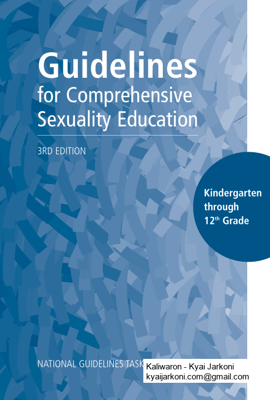Sexuality is a central part of being human, and individuals express their sexuality in a variety of ways. Key Concept 5: Sexual Health. The promotion of sexual
157 KB – 112 Pages
PAGE – 2 ============
Copyright ©2004 by the Sexuality Information and Education Council of the United StatesNo part of the Guidelines for Comprehensive Sexuality Education: Kindergarten-12thGrade, Third Editionmay be reproduced in any form without written permission.Design and layout by Anna Raff Proofing by Phil Banner and Beej JohnsonPrinting by Fulton Press
PAGE – 5 ============
AcknowledgementsFor over a decade, SIECUS has published the Guidelines for Comprehensive Sexuality Education:Kindergarten-12thGradeto help educators create new sexuality education programs and evaluate already existing curricula. The Guidelines, developed by a national task force of experts in the fields of adolescent development, health care, and education, provide a framework of the key concepts, topics, and messages that all sexuality education programs would ideally include. This Third Edition of the Guidelinesis based on the work of the original National Guidelines Task Force; the basic structure and content remain the same. Certain topics, messages, and age-levels, however, have been changed to reflect new information and the reality that todayÕs young people are facing. In addition, we have added a section on using the Guidelines that provides specific advice, ideas, and resources to help educators implement this important framework into their efforts to provide high-quality sexuality education to young people in their schools and communities. Since they were originally developed 13 years ago, the Guidelineshave become one of the mostinfluential publications in the field and a trusted resource for educators, curriculum developers, and school administrators. SIECUS has distributed well over 100,000 copies of this publication. In fact, the Guidelinesare downloaded from SIECUSÕ website by more than 1,000 people each month. Given how popular and valuable this publication is, undertaking this revision was at the same time exciting and daunting, and we have many people to thank for the success of the final product. First we would like to thank the John M. Lloyd Foundation and Barbara Stanton whose generous support made it possible for SIECUS to produce this vital resource. We must also thank all of the members of the original task force for the enormity of the task they took on. There is a phrase in the publishing world that asks ÒWhere were you when the page was blank?Ó Having worked for over a year to update and revise the Guidelines, we cannot imagine theeffort and patience it must have taken to start from scratch. In addition, a number of former and present SIECUS staff members assisted us in updating messages and adding new information and ideas including Myra Batchelder, Kate McCarthy, Jason Osher, Ambika Panday, Coralie Meade Rodriguez, Darlene Torres, and Adrienne Verrilli. We give special thanks to Amy Levine who spent a great deal of time helping us perfect messages. We would also like to thank Joseph DiNoricia, Jr., SIECUS President and CEO, for his guidance and leadership on this project. Finally, we must thank all of our reviewers. For this edition of the Guidelines, we assembled a panel of experts in the field to review the concepts, topics, and messages. We owe a tremendous debt of gratitude to Nora Gelperin, Eva Goldfarb, Joan Helmich, Maureen Kelly, Lis Maurer, Elizabeth Schroeder, and Bill Yarber. Their comments and ideas were always insightful, often inspirational, and occasionally humorous. This revision would not have been possible without their input. It is our sincere hope that this edition of the Guidelinesis a valuable resource for educators and curriculum developers and that it ultimately helps to ensure that all young people receive the comprehensive education about sexuality they need to become sexually healthy adults. Sincerely, Martha E. Kempner, M.A. Monica Rodriguez Director of Public Information Vice President for Education and Training
PAGE – 6 ============
Peggy Brick, M.Ed.Planned Parenthood of Greater Northern New Jersey Maureen Corry, M.P.H. March of Dimes Birth Defects Foundation Brenda Green National School Boards Association Debra Haffner, M.P.H. Sexuality Information and Education Council of the United States Marian Hamburg, Ed.D. New York University Carol Hunter Geboy Independent Sexuality Education Consultant Richard Jimenez, M.Ed. Centers for Disease Control and Prevention Robert Johnson, M.D. New Jersey Medical School Michael McGee, C.S.T. Planned Parenthood Federation of America JoAnne Pereira Sexuality Information and Education Council of the United States Martha Roper, M.S. St Louis, Missouri Public Schools Clair Scholz, M.A. Irvington, New Jersey Public Schools Robert Selverstone, Ph.D. Westport, Connecticut Public Schools Stanley Snegroff, Ed.D. American School Health Association Mary Lee Tatum, M.S. Independent Sexuality Education Consultant Trish Moylan Torruella, M.S. Planned Parenthood Federation of America Katherine Voegtle, Ph.D. American Medical Association James Williams National Education Association Pamela Wilson, M.S.W. Independent Sexuality Education Consultant William L. Yarber, H.S.D Indiana University * 1991 affiliations, for identification purposes only. Original Members of the National Guidelines Task Force *
PAGE – 9 ============
Table of Contents Background and Introduction 9 History of the Guidelines12Structure of the Guidelines13Goals, Values, and Fundamental Principles 17 Guidelines for Comprehensive Sexuality Education: Kindergarten Ð 12th Grade..21Key Concept 1: Human Development 22 Key Concept 2: Relationships 31 Key Concept 3: Personal Skills 40 Key Concept 4: Sexual Behavior 48 Key Concept 5: Sexual Health 55 Key Concept 6: Society and Culture 68 Using the Guidelines77Prioritizing Topics 79Filling in the Gaps80Evaluating Existing Curricula and Lessons 84 Creating New Curricula and Lessons 98 Additional Resources.101 Also IncludedLife Behaviors of a Sexually Healthy Adult 14 Key Concepts and Topics 16 Curriculum Evaluation Tool 87 STDs/HIV Checklist94
157 KB – 112 Pages
